History
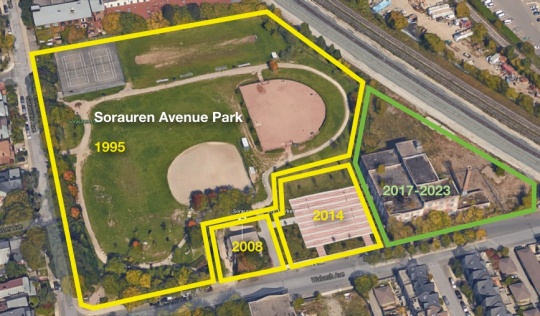
The main park area was opened in 1995. The Fieldhouse was added in 2008, and the Town Square in 2014. The final phase, the Community Centre, will take place over 2017-2023.
The history of Sorauren Park, the Fieldhouse, the new Sorauren Town Square and the future Wabash Community Centre is a long story of neighbourhood activism and City involvement to improve the quality of life in our part of Toronto. And just prior to the park, the site had an industrial history important to the development of modern Toronto.
(If you want to add to the historical knowledge, send old photos, or correct any facts here, please contact us. For the history of Charles G. Williams Park across Wabash Avenue from Sorauren Park, click here.)
This part of Toronto falls in the Humber River watershed, and is walking distance from the river’s mouth at Lake Ontario. This area has seen human activity for thousands of years, with the river and the parallel Carrying Place Trail serving as a vital transportation route connecting what’s now called Lake Ontario and the route to the Atlantic with the upper great lakes, bypassing Niagara Falls. A great Mohawk-Seneca village called Taiaiako’n was one of the more recent Indigenous settlements on the banks of the river, not far away in what is now called Baby Point neighbourhood.
The land that now holds the park was part of the controversial 1805 Toronto Purchase (Treaty 13) between the British occupiers and the Anishinaabe people at the time. The Anishinaabe people and leadership considered the Treaty an agreement to share the land; the British considered it a land transaction.
Prior the Toronto Purchase and its predecessors, the territory fell under the Dish With One Spoon treaty between the Anishinaabe, Mississaugas and Haudenosaunee peoples to share and protect the land peacefully.
The Toronto Purchase Claim was just settled with the Mississaugas of the Credit First Nation in 2010. The Friends of Sorauren Park recognize this land as part of the traditional territory of many First Nations that have come before us and that continue to live here.
Sorauren itself is named after the Battle of Sorauren in the Roncesvalles Pass in the Pyrenees Mountains in Spain, near the city of Pamplona. Col. Walter O’Hara, who settled in this part of Toronto and named the local streets, fought in that battle in 1813 during the Napoleonic Wars.
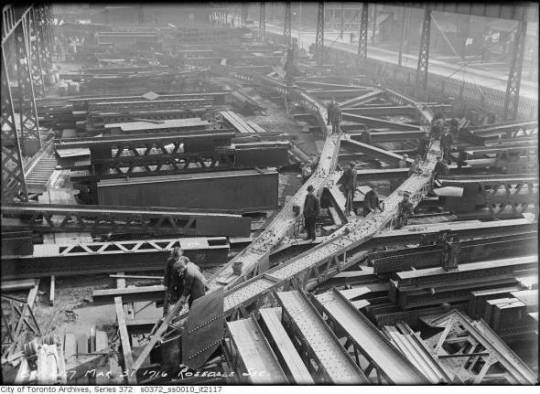
Girders for the Bloor Street Viaduct under construction at Sorauren Park, then the Dominion Bridge Steel company, 1916, from Toronto Archives. Sorauren Avenue visible in the background
The park site encompasses two old properties. The main property on Sorauren Avenue was first a plant for the Dominion Bridge Steel company. Among its projects was making the steel girders for the Bloor Street Viaduct around the time of the First World War. See more pictures at Lost Toronto (thanks to Greg Chown).
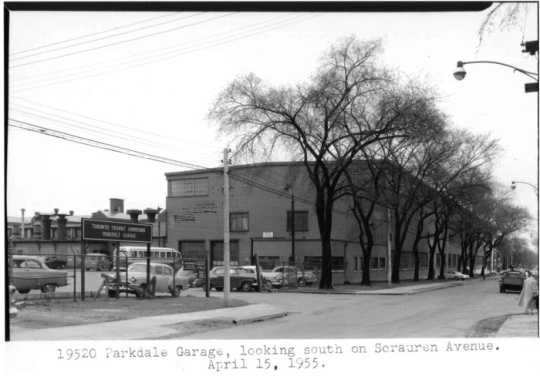 Between the world wars, the TTC took over the site to create the Parkdale bus garage until the 1980s. Decommissioned, it was briefly a film studio; a made-for-TV sci-fi series called Captain Power and the Soldiers of the Future was made there. When the site was slated to become a garage for municipal garbage trucks, the community had other ideas, and the battle was on to establish a much-needed neighbourhood park.
Between the world wars, the TTC took over the site to create the Parkdale bus garage until the 1980s. Decommissioned, it was briefly a film studio; a made-for-TV sci-fi series called Captain Power and the Soldiers of the Future was made there. When the site was slated to become a garage for municipal garbage trucks, the community had other ideas, and the battle was on to establish a much-needed neighbourhood park.
After countless volunteer hours and actions, Sorauren Avenue Park was officially opened on September 17, 1995. Barbara Hall was mayor at the time, and see her and others recall the opening of the park in this video prepared by the Roncesvalles Macdonell Residents’ Association. Landscaping was built up over the old concrete pad of the transit garage, a cheaper alternative to removing the concrete. Drainage over much of the park suffers because of this, with trees and grass having a hard time growing except around the margins of the park where there is no underlying concrete. The community celebrated the park’s 20th anniversary in 2015.
All during this time, the vision for the precinct extended to building a new community centre near the park, on the former property of the Canada Linseed Oil Mills Ltd. More history and photos on the proposed Wabash Community Centre can be found here. Also read the fascinating history of the linseed mill by historian David Wencer on spacing.ca here.
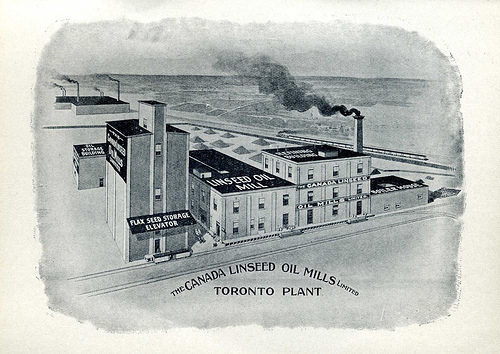
Illustration showing the linseed (flax) mill on Wabash Avenue. The tall flax seed elevators are gone. The mill and chimney still stand, abandoned. Rail spurs come up Wabash Avenue.
With an eye to building the community centre, the City bought the derelict linseed mill property on the north side of Wabash Avenue, adjacent to the park, in 2000 for approximately $2 million. (Chris Korwin-Kuczynski was councillor at the time.) The property contains the 40,000 sq. ft. former plant of the Canada Linseed Oil Mills, built in 1915 of solid concrete, but abandoned since about 1970. The plant processed flax seed, also called linseed, for decades.
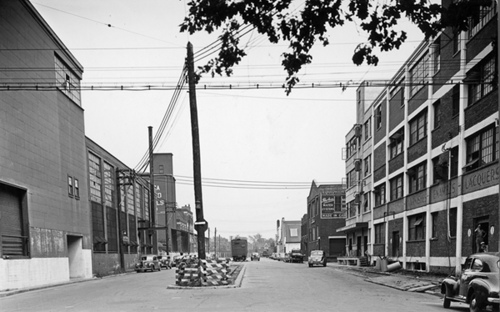
Looking down Wabash Avenue from Sorauren Avenue, 1947. The building on the left shows where Sorauren Park now exists. The building on the right is now Charles G. Williams Parkette. The building on the right with the peaked roof is now Addison’s Plumbing.
Rail spurs from the Grand Trunk rail line (now the Metrolinx Kitchener-Georgetown line) went into the plant and up the centre of Wabash Avenue to serve industry. In 2003, a City-commissioned feasibility study showed the old flax mill building could be converted into a community centre, an idea supported by residents through several surveys and community meetings.
There is also a smaller 2,000 sq. ft. building on the site, formerly the administrative offices for the linseed mill, and now converted into the bustling Sorauren Park Fieldhouse.
The Fieldhouse building has a colourful past. After decommissioning for the linseed operations, for some years it was a noted after-hours speak-easy. If you can contribute to this part of the history, let us know!
In 2004, while Sylvia Watson was councillor, the City conducted a major $1-million environmental clean-up of the site, removing contaminated soil and asbestos in the old buildings.
In 2006, a community group borne out of the Roncesvalles-Macdonell Residents’ Association formed to become the Wabash Building Society, a non-profit corporation dedicated to restoring the Wabash property to community use.
As part of a “baby steps” campaign, the WBS focused on developing the Fieldhouse to quickly provide washrooms, storage space and meeting space for the park. Over the years, the children’s sports league in the park has grown from about 100 kids to more than 750 registered each season… all serviced by two temporary porta-potties.
Thanks to the efforts of the community, a fundraising campaign, grants from the Evergreen Foundation, in-kind donations, “Section 37” development fees from nearby condo and loft developments, and City support, Fieldhouse construction began in October 2007. The building opened in May 2008.
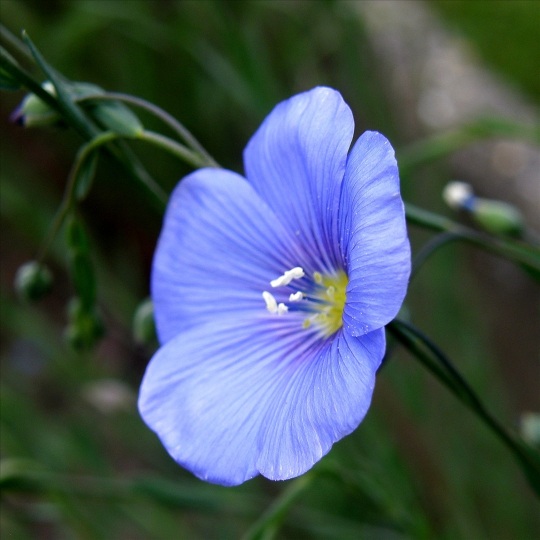
The miraculous flax plant upon which the linseed oil industry was built. Flax has been cultivated for at least 3,000 years because of its many uses, including human food (high in omega-3), animal feed, oils, textiles (linen) and now biofuel.
Previous Ward councillors, current councillor Gord Perks, former mayor David Miller, and many dedicated City staff were instrumental in bringing the Fieldhouse to life. In 2006, the Wabash Building Society and the City accepted a prestigious Brownie Award from the Canadian Urban Institute for the work done to date by all volunteers on restoring the entire Sorauren “brownfields” site to community use. (To see all park supporters, click here.)
The WBS then set its sights on the vacant land still fenced off between the Fieldhouse and the old linseed factory. The site once housed the grain elevators for the flax seed, serviced by the rail spur. In July 2014, following a community fundraising campaign with support from Live Green, TD Friends of the Environment, Councillor Gord Perks and the City, the new multi-use Sorauren Town Square was opened. It is a new home for the Sorauren Farmers’ Market and many other community uses, including a community vigil in 2021 to honour the 215 Indigenous children whose remains have been detected at the former Kamloops Residential School. 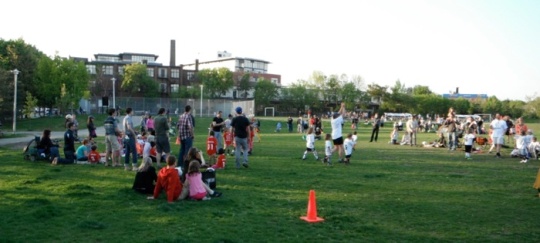
In 2016, to better reflect its evolving mission, the WBS changed its operating name to Friends of Sorauren Park (the corporate name remains Wabash Building Society).
Sorauren Park is our patch of green space and blue sky. Our meeting place. It has a pleasing view of downtown, the CN Tower and St. Helens. It is well used and maybe even loved by thousands of Torontonians from all walks of life and backgrounds. It is home to busy tennis courts. Soccer and baseball teams. Cricket players. Kite flyers. Joggers. Dog walkers. Skaters (when winter accommodates a natural ice rink). The Pumpkin Parade. Christmas carollers. Birthday parties. Picnics. Community events. The Holly Jones memorial garden. The RMRA presidents’ tree. The Fieldhouse and Town Square. The Sorauren Farmers’ Market. The first of many future generations of kids to grow up in the park has now entered adulthood.
And there’s still work to be done! 40 Wabash Avenue, the old flax plant, looms over the park, waiting for its transformation into the Wabash Community Centre. City Council voted to approve the Wabash Community Centre in 2017, with a forecast completion date of 2026. The Friends of Sorauren Park and other groups remain committed to the original mission, and they invite your ideas, donations and participation.
See you at the park.

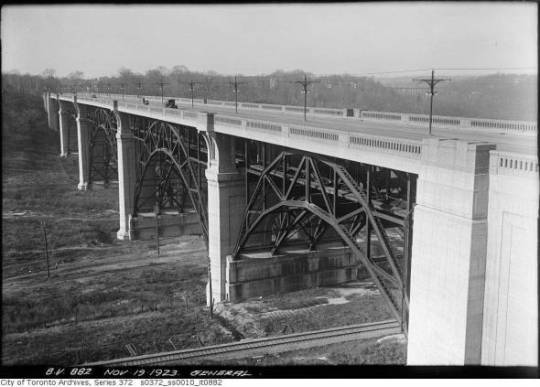
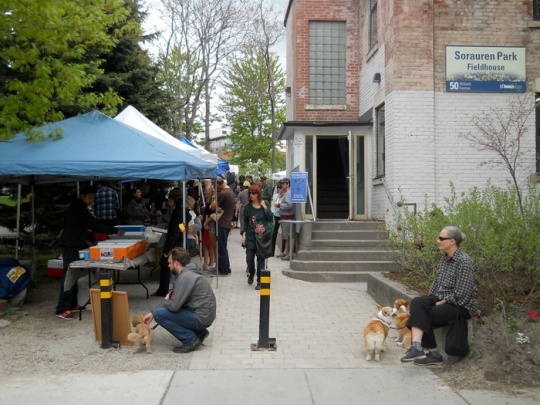
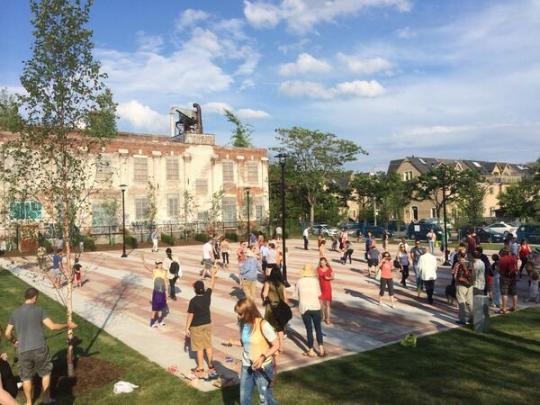
Hi,
I was wondering if you know any information about the land before the linseed mill was constructed. Was there anything built before or any events that happened on that land?
Thank you,
Jenny
Hi, we don’t have our hands on the history of the linseed site immediately prior to that use. The land was forested (for probably thousands of years), then briefly farmland judging by old maps, then following the building of the adjacent Grand Trunk Railway (now the Kitchener GO line) in 1856, industry moved in. The main part of Sorauren Park was Dominion Bridge Steel Company, then TTC Parkdale bus garage as this page describes. We’ll add any additional history we learn to this page. Thanks for your interest!